-
December 6 1778

Birth of Joseph Louis Gay-Lussac
On this day was born in Saint-Léonard-de-Noblat, the French chemist Louis Joseph Gay-Lussac best known for his work on gases. In 1805, by exploding together given volumes of hydrogen and oxygen, Gay-Lussac discovered they combined in ratio 2:1 by volume to form water. By 1808, after researches using other gases, he formulated his famous law of combining volumes - that when gases combine their relative volumes bear a simple numerical relation to each other (e.g., 1:1, 2:1) and to their gaseous product (under constant pressure and temperature).
As a young man, Gay-Lussac had participated in two balloon flights for scientific purposes. In 1804 he ascended in a hydrogen balloon with Jean-Baptiste Biot in order to investigate the Earth's magnetic field at high altitudes and to study the composition of the atmosphere. Also in 1805-06, amid the Napoleonic wars, Gay-Lussac embarked upon a European tour with the Prussian explorer Alexander von Humboldt.
He also developed techniques of quantitative chemical analysis, confirmed that iodine was an element, discovered cyanogen, improved the process for manufacturing sulphuric acid, prepared potassium and boron (1808).
He died on May 9, 1850 in Paris. -
December 1 1783
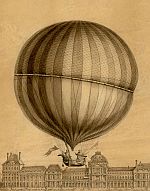
First balloon manned flight using Hydrogen
On this day in 1783, less than two weeks after the ground-breaking Montgolfier flight, the French physicist Jacques Charles and Nicolas Robert made the first un-tethered ascension with a gas hydrogen balloon. Charles combined his expertise in making hydrogen (mixing huge quantities of sulfuric acid with iron filings), with Robert's new method of coating silk with rubber.
The balloon was released from the Tuileries Gardens in front of near 400.000 people, which at the time was half the population of Paris. It ascended to about 600 m and landed 43 km away in Nesles-la-Vallée after 2 hours aloft. Robert then left the balloon, and Charles decided to ascend again, alone, reaching a maximum altitude of 2700 meters.
The balloon was almost spherical and counted with a net, a load ring, a commandable valve to vent gas, an open appendix and used sand as ballast. All these elements would be universally adopted for gas balloons from that moment on. Also this was the first balloon flight to provide meteorological measurements of the atmosphere above the Earth's surface because Charles and Robert carried a barometer and a thermometer with them to measure the pressure and the temperature of the air. -
December 2 1804

Napoleon's coronation balloon goes astray
When Napoleon decided that he would be crowned emperor of France in 1804, he asked Jeanne Genieve Garnenin and her husband, Andre Jaques Garnenin, who were their Official Aeronauts, to offer an aerial spectacle to celebrate the occasion. The couple built a huge unmanned balloon and decorated it with a large crown of three thousand lights. It was launched on the day of the ceremony, December 2 in front of the cathedral of Notre Dame.
Once in the air, the wind would take the aerostat to cross the Italian border and with amazing precision sent it over the tomb of the infamous Roman emperor Nero. The crown, conceived as a celebration of Napoleon, detached itself from the aerostat and landed with a certain parsimony air over the monument of the dead Emperor, while the balloon continued to fly and was later captured over Lake Bracciano. The Italians were furious and amused to the same extent, and their newspapers took the opportunity to highlight some unflattering similarities between Bonaparte and Nero. -
December 22 1870
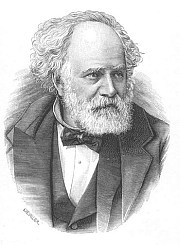
Balloon flight studies eclipse
On this day in 1870 Jules César Janssen a French astronomer, flew in a balloon in an attempt to study a solar eclipse in Algeria, north africa. Using the balloon he escaped the German siege of Paris during the Franco-Prussian war and reached Oran, Algeria, but sadly the eclipse was clouded out.
Janssen had devised in 1868 a method for observing solar prominences without an eclipse, an idea reached independently by Englishman Joseph Norman Lockyer. Using a spectroscope during the total Sun eclipse in India that year, he proved that the solar prominences are gaseous, and identified the chromosphere as a gaseous envelope of the Sun. He noted an unknown yellow spectral line in the Sun, and told Lockyer who subsequently recognized it as a new element he named helium, from Greek helios for sun.
Janssen was the first to note the granular appearance of the Sun, regularly photographed it, and published a substantial solar atlas with 6000 photographs in 1904. -
December 5 1903

Birth of Cecil Frank Powell
On this day in 1903 was born Cecil Frank Powell, an English physicist. He earned his Ph.D. in Physics in 1927. In 1928 he took up a post as Research Assistant to A.M. Tyndall in the H.H. Wills Physical Laboratory at the University of Bristol, later being appointed lecturer, and in 1948 appointed Melville Wills Professor of Physics. During his time there, Powell applied himself to the development of techniques for measuring the mobility of positive ions, to establishing the nature of the ions in common gases, and to the construction and use of a Cockcroft generator to study the scattering of atomic nuclei. He also began to develop methods employing specialised photographic emulsions to facilitate the recording of the tracks of elementary particles, and in 1938 began applying this technique to the study of cosmic radiation, exposing photographic plates at high-altitude, at the tops of mountains and using stratospheric balloons. Powell's group at Bristol, performed many balloon launches from the grounds of the University, as well in Cardington, Bedfordshire. Also during that same decade Powell directed several balloon launch expeditions to Sardinia and the Po Valley, in Italy which involved many universities across Europe.
In 1950 he was awarded the Nobel Prize for Physics "for his development of the photographic method of studying nuclear processes and his discoveries regarding mesons made with this method".
Powell died on 9 August 1969, whilst out walking in the foothills of the Alps, near Valsassina, Italy. -
December 17 1956
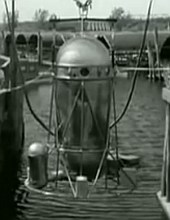
First test of MANHIGH capsule
On this day, Winzen Research Inc. tested the capsule built for the MANHIGH project of the U.S. Air Force before the first manned mission which would be performed on June 1957. The flight, which was launched from the bottom of the Portsmouth iron mine near Crosby, Minnesota, carried onboard a colony of mice and hamsters that placed the same demands on the air regeneration system as a human pilot and also served as specimens for cosmic radiation studies.
After launched the balloon ascended to 97.000 ft when suddenly it burst. At the time it was being followed closely by a tracking aircraft which witnessed that the capsule started to fall to earth. Fortunately the shreds of the gigantic balloon acted like a streamer and slowed the capsule enough that it wasn't damaged upon landing. Next morning the recovery team trudged through knee-deep snow to reach the capsule and its occupants. The animals and capsule were both in good shape when they were recovered. -
December 12 1958

Flight of the Small World
On this day, a group of 4 British aeronauts, Colin Mudie, his wife Rosemary, Bushy Eiloart and his son Tim, attempted to cross the Atlantic Ocean in the "Small World" balloon by taking the east-west route. The trip would begin in Tenerife, in the Canary Islands, with destination to the east coast of the United States.
The balloon took off on December 12, 1958 and for the first four days it traveled 1200 nautical miles, breaking all existing balloon flight records for its time. Unfortunately, the aerostat was caught by a storm and fell into the ocean, ending the crossing attempt early. However, its occupants survived well the accident thanks to the fact that the gondola had been constructed of reinforced polystyrene with a strong and resistant structure able to withstand the impact if they fell into the sea at any point of the flight.
Using the gondola as an improvised boat, the crossing continued by sea since the four aeronauts were also experienced sailors. They were able to sail another 1,450 miles for 20 days, finally arriving on land in Barbados on January 5, 1959.
The complete adventure was published in the July 1959 edition of the National Geographic Magazine. -
December 11 1959
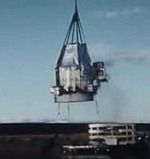
Second jump of the EXCELSIOR program
The second mission of Excelsior, the program of the Air Force of the USA. UU aimed at testing whether pilots could survive a parachute ejection at high altitude - in this case from a stratospheric balloon - took place on December 11, 1959.
One hour after the launch from Holloman Air Base, Captain Kittinger floated at 74,700 feet above the New Mexico desert. Unlike what happened during the first jump when the parachute became entangled in his neck and caused an uncontrolled turn that made him lose consciousness, this time everything worked perfectly. Immediately after jumping out of the gondola, Kittinger started a slow spin but slightly lowered one foot and his arm and the spin stopped. Fourteen seconds after leaving the balloon, the pilot parachute deployed and the sequence was completed when the main parachute was opened at 18,000 feet, exactly as planned.
After this jump Kittinger would receive the Harmon International Trophy. In addition, the success of the mission paved the way for the final test of the program that would take place in August 1960. -
December 12 1962
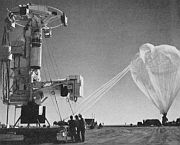
STRATOSCOPE II balloon shoot down by US Navy fighters
On December 12, 1962 was performed the first full-scale test flight, for the Stratoscope II project using a mockup of the real telescope. The tandem balloon system needed to rise the five ton mass of the instrument was launched at twilight from Palestine, Texas, on the grounds of the future NASA balloon base, then operated by NCAR.
The balloon performed flawlessly during the night but at dawn, a signal was sent to valve the apparatus down, but the balloon didn't respond. An automatic timer triggered the exhaust valve, and the balloon came to earth near Krotz Springs, Louisiana, but the ballast container spilled accidentally and the balloon rose again, but only to 14,000 feet, since much of its gas had been valved off. As a result the balloon drifted across the Gulf of Mexico and Florida, then out over the Atlantic. When approaching heavily traveled air lanes, it became a navigational hazard and thus two Navy F4B phantom interceptors were sent from Boca Chica Naval Air Station which fired Sparrow missiles to take it down, about 100 miles off the coast. -
December 13 1962

STARGAZER performs manned astronomical observations
On this day, in 1962, was performed the only manned flight of the Stargazer project. The general purpose of the program was to test the feasibility of doing astronomical research from a manned balloon-borne vehicle in the stratosphere. It was initiated in 1957 at the Smithsonian Astrophysical Observatory by the Air Force Office of Scientific Research. Later, the balloon part of the program was under the sponsorship of the Air Force Cambridge Research Laboratories while the scientific portion was headed by Dearborn Observatory, Northwestern University under the guidance of Dr. J. Allen Hynek. The project performed a total of five unmmaned test flights and the only manned flight in 1962. The full fledge mission was launched from Holloman AFB and was piloted by Capt. Joseph W. Kittinger. William White a US navy civilian astronomer was the scientific officer of the mission.
A second flight was intended to be performed in April 1963, but while preparing the launch, the separation mechanism that connected the capsule and the balloon fired, releasing the balloon without its cargo. After that the program was cancelled. -
December 17 1964

Victor Francis Hess dies
On this day of 1964, died in Mount Vernon, New York, the Austrian-American physicist Victor Hess who shared with Carl D. Anderson of the United States the Nobel Prize in Physics in 1936 for his discovery of cosmic rays.
He had emigrated from his native Austria to the United States in 1938, then naturalized.
By means of instruments transported aboard balloons that he himself manned, Hess and others demonstrated that the radiation that ionizes the atmosphere is of cosmic origin. He experimented in 1939 with a 27-day cycle of cosmic ray intensity in the sun's magnetic field and correlated it with the 27-day rotation period of the sun. He also worked on the design of methods to detect small amounts of radioactive substances.
Throughout his life Hess made fundamental contributions to the understanding of radiation and its effects on the human body. -
December 8 1976

Flight of the ATMOSAT AMERICA
On this day was performed a manned flight of the ATMOSAT AMERICA balloon over southwestern US.
The ATMOSAT (Atmospheric Satellite) was a manned superpressure balloon which was developed by The Aerospace Corporation a private company from California to provide a means for accurately following a parcel of air, making physical and chemical measurements en route. The balloon was made of a composite of high strength fabrics that allowed to contain its lifting gas (helium) under pressure, thereby providing long term flight stability unachieved by any other method.
After several tests performed since 1975, Flight 4 was the first one of a series of pollution monitoring missions for the project. It was launched from Farmington, New Mexico, just downwind of the Four Corners Power Plant, a large coal burning facility, on December 8 1976 and was terminated 7 hours and 16 minutes later outside Blanding, Utah.
This mission primarily proved that a free flight drift can be performed in order to track a pollution plume in mountainous terrain even at night. Also served to collect atmospheric data: ozone, NOx, SO2, temperature gradients, turbulence, and other parameters. Finally, it paved the way for a series of flights in the following years to measure specific contaminants under contract with local governments and industrial companies. -
December 19 1977
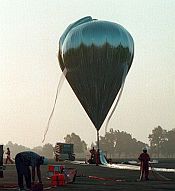
First successfull flight of a MIR balloon
On December 19, 1977, was launched from the Aire Sur L'adour CNES balloon base the first proof-of-concept model of an Infrared Montgolfiere (MIR) balloon. The MIR is a hot air stratospheric balloon that captures infrared radiation using the earth as a heat source. It is capable of lifting 50-kg payloads into the stratosphere for periods of several weeks.
The test performed over France, consisted of a MIR balloon measuring 5,600 m3. It flew successfully, and was deliberately cut down after 3 days aloft. This was the only long-duration test ever performed in Europe's mid-latitude with these balloons. -
December 25 1990
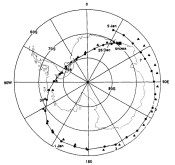
Polar Patrol Balloon first test
In 1984, the National Institute of Polar Research and the Institute of Space and Astronautical Science from Japan started the so called Polar Patrol Balloon (PPB) project to study the feasibility of a long-term circumpolar experiment to carry scientific payloads in the stratosphere over the Antarctic region.
After some preliminary tests in 1987 and early 1990, the first flight of the system was launched from Syowa Station on 25 December 1990. After reaching an altitude of 30 km the system started to drift in a westward pattern carried by the polar vortex. The balloon with a volume of 25.000 m3 transported onboard a proton magnetometer that measured the total force of the geomagnetic field.
At 22:30 utc on January 8, 1991, the PPB passed 400 km north of the launch site, thus achieving the first complete circumpolar turn of the project on the white continent. The flight would end on the 1st of February of the same year. During the 38 days of flight, useful information was obtained about the anomalies of the polar region, the geomagnetic variations of high latitude on the auroral zone, the polar cap and the region near the south geomagnetic pole. -
December 31 1994
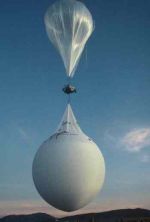
Last flight of EARTHWINDS project
On this day, was performed the last of the five attempts of the EARTHWINDS project, which were a series of balloon missions performed along the 90's decade by aeronaut Larry Newman trying to achieve a world circumnavigation using the jet stream winds.
The system consisted of two balloons, an upper lifting balloon about 200 feet high filled with 1.1 million cubic feet of helium, and a 100-foot-diameter anchor balloon filled with compressed air suspended beneath the pressurized crew capsule. By pumping additional air into the anchor balloon the crew made it heavier, preventing the balloon from rising high enough to necessitate the release of helium. By releasing air from the anchor the balloon was lightened. This feature allowed the balloon to avoid the need of using conventional sand ballast, which would be exhausted after a few days.
This last mission was piloted by aeronaut Larry Newman, along with David Melton and George Saad and was launched from Reno, Nevada. However, four hours later, it was back on the ground near Falloon, Nevada due to the failure of the ballast balloon. -
December 29 1998
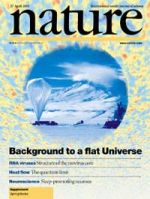
BOOMERANG mission in Antarctica observes CMB
On this day in 1998, after over five years of development through an extensive collaboration between 16 universities from Italy, United States, Canada and the UK, the BOOMERANG (Balloon Observations of Millimetric Extragalactic Radiation and Geophysics) instrument made its first long duration flight above Antarctica. Launched onboard a NASA stratospheric balloon it remained eleven days floating above the white continent collecting data on the anisotropies of the fossil radiation from the Big Bang known as the Cosmic Microwave Background Radiation.
After the flight, the BOOMERANG team spent 16 months working to interpret the vast quantities of data collected, resulting in a picture of the universe long before the first stars or galaxies formed. The discovery made the cover of the Nature magazine in April 2000.
At the time of its release, the data from this flight was of unprecedented quality. The instrument's sensitivity, frequency coverage, and angular resolution allowed the unambiguous measurement of temperature fluctuations in the cosmic microwave background over a broad range of angular scales. The basic scientific result of this mission was the determination that the Universe appears to be geometrically flat.

